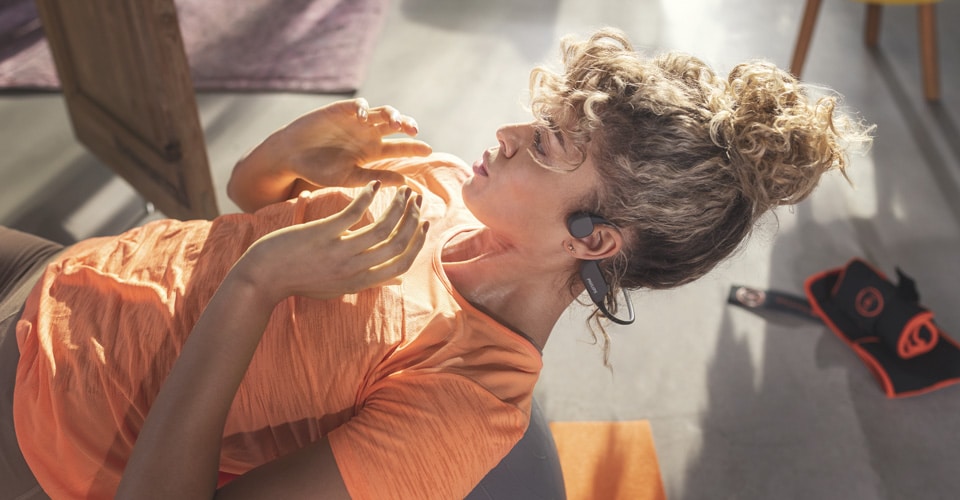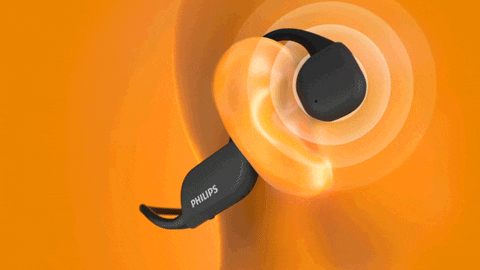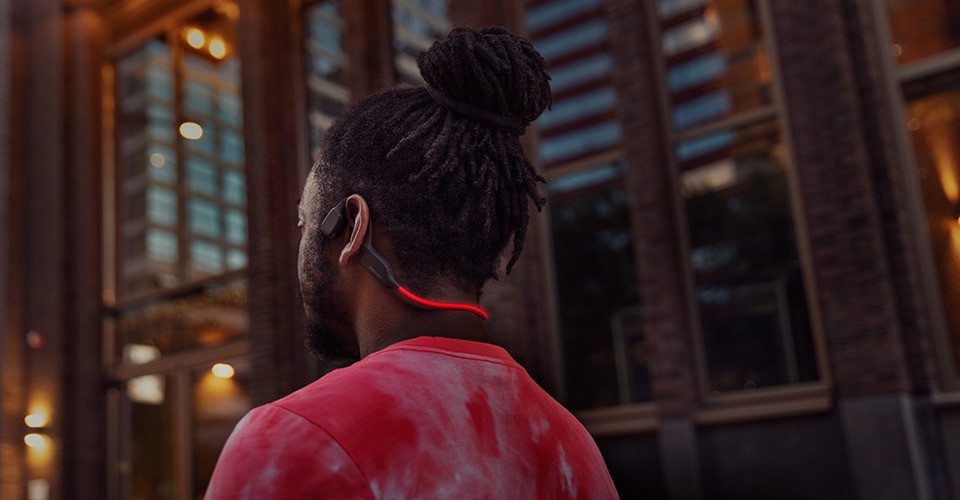Find out what bone-conduction (bone-conducting) headphones are, and why you might want to own a pair. You’ll learn how bone-conducting headphones work, why they’re the safest choice if you run or cycle—and how Beethoven played a role in the history of the technology!

Free your ears: Introducing bone-conduction headphones
Bone-conduction headphones, also known as ‘open-ear headphones’, don’t go in your ears like earbuds. And they don’t cover your ears or sit on top of your ears like over-ear or on-ear headphones. But bone-conducting headphones will still let you hear your favourite podcasts and playlists clearly. So what exactly are they?
Bone-conduction headphones send sound waves through your skull instead of your ear drum. This lets you hear what you’re listening to without the need to put tiny speakers in or on your ear. It’s like the music—or podcast—magically appears inside your head!
So: how does the magic happen?

How do bone-conduction headphones work?
To understand how bone-conduction headphones work, we first need to understand how we hear.
Humans hear when the bones of the inner ear vibrate. In total, you have three bones in your inner ear, and together they’re called the auditory ossicles. These bones transmit sound vibrations through the cochlea, which is a fluid-filled, snail-shaped internal-ear structure. As your cochlear fluid vibrates, thousands of nerve endings transform the vibrations to electrical impulses. The auditory nerve then sends this information to the brain, the brain recognises the information as sound—and you hear Beethoven’s Fifth in all its glory. Or the latest hot take from your favourite podcaster.
Normally, it’s your eardrum that causes the bones in your ear to vibrate. Soundwaves reach the eardrum first, and they make it move. Those movements start vibrations in the auditory ossicles—and then you get the whole cochlear fluid/nerve endings thing happening, as described above.
But you don’t have to make your eardrum move to hear something. There are other ways to make the bones in your inner ear vibrate—and that’s how bone-conduction headphones work.

If you’ve ever seen someone running or cycling with what looks like a Star Trek-inspired headband on, then you’ve probably seen a pair of bone-conduction headphones. They wrap comfortably around the back of the head, and the speaker rests on your cheekbone just in front of your ear. The speaker sits directly on your zygomatic arch—this is the bone you can feel if you run your finger from the edge of your eye back to your ear.
When you play music or podcasts through bone-conducting headphones, the vibrations pass from the speaker through your zygomatic arch into the inner-ear bones—making them vibrate so you can hear what you’re listening to.
Brilliant, right? This all means that you can slip on a pair of bone-conduction headphones, fire up your favourite podcast or audiobook, and your ears remain completely open. The fact that there’s nothing in your ears is also why bone-conducting headphones are sometimes referred to as ‘open-ear headphones’. You’ll hear what you’re listening to—and the sounds of the environment around you too.
The history of bone-conducting headphones
You’d think that such Star Trek-style headphone technology would be a recent invention.
In fact, bone-conduction technology has been around for a good while. It’s relatively new to the headphone user but, in one form or another, bone-conducting devices have been used since at least the 19th century.
Beethoven’s piano and other instruments: bone conduction in early medicine
The first person to use bone conduction in connection with hearing was probably Hieronymus Capivacci—a 15th-century physician from Padua in Italy who used bone-conducting materials to diagnose the causes of severe hearing loss in his patients. Capivacci attached a metal rod to the strings of a zither (a type of stringed instrument), and had his patients clamp the rod in their teeth.
If a patient could hear music when the zither was played, the diagnosis was a disorder of the eardrum. If the patient heard nothing, the problem was diagnosed as a disorder of the auditory nerve.
Similarly, the famously deaf composer Beethoven was reported by his housekeeper to have clamped one end of a pencil between his teeth and touched the other end to his piano as he played, enabling the vibrations of his music to pass into his inner ear via the bones in his skull. (Other sources say he used a metal rod instead of a pencil, which attached to his head).
150-odd years later, bone-conduction headphones work with the exact same principle, namely that vibrations can pass through the bones of the skull to the inner ear.
Wired to wireless: bone-conduction headphones hit the market
The very first commercially available bone-conduction headphones are thought to be the Audio Bone—a wired headphone designed for general use, which appeared on the market in 2008. And the technology has been evolving steadily ever since, with Philips releasing its first pair of open-ear bone-conducting headphones—the A6606—in 2021.
Nowadays, the benefits of bone-conduction headphones are starting to be appreciated by a wide range of people who enjoy sport like running and cycling. And the athletic community has been an enthusiastic adopter of bone-conduction technology, thanks to the safety benefits conferred by leaving your ears open to environmental sound. Indeed, England Athletics (the UK-wide governing body for competitive athletics) has ruled that only open-ear bone-conduction headphones may be used in road races.
Safety first: Running or cycling with bone-conduction headphones
Bone-conduction headphones are the ideal choice for safety-conscious athletes, particularly runners and cyclists.
Why those sports? The reason is pretty simple: bone-conduction headphones let you hear traffic sounds clearly. With your ears unobstructed, there is nothing blocking you from hearing the approach of a car or moped, or the ring of a bike bell.
This is why England Athletics—the membership and development body for athletics and running clubs in England—only allows cyclists and runners to wear bone-conduction headphones in road races. No other type of headphone is allowed in any event ‘where roads are open to traffic’.
Does this mean bone-conduction headphones will always let you hear external sounds?
No. It’s still possible to mask sounds coming from the outside world if you crank up the volume on your bone-conduction headphones too high. Once the sound generated by the headphones reaches a volume that overcomes the volume of traffic sound, you can run or ride without hearing what’s around you. So, a word to the wise: if you want to play it safe, set a sensible volume for that podcast before you head out!

How do bone-conducting headphones keep you safe?
Of course, it’s not only on the open road that you might—literally—run (or ride!) into situations in which you need to hear what’s happening around you.
Picture this scene: you’re running in the woods, or your local park. You kind of hate running a little bit today. It’s raining. And, while the IP66 rating on your bone-conduction headphones can handle the wet, you would rather be at home! So, you fire up a podcast or audiobook to take your mind off the lactic acid building in your thighs, and the water pouring down your forehead.
You’re losing yourself in the twists of the thriller you’re listening to, or your favourite podcaster’s latest take on the newest movies…
And then a bike comes swooshing past, causing you to leap into a bush to save yourself.
Only you don’t have to do that, of course, because you’re wearing bone-conduction headphones. Which means you actually heard the bell that the cyclist was ringing, and you stepped neatly to one side way before they ever got close enough to present a danger to you.
Or, you are the cyclist. You’ve been pedalling for half an hour. You have rain up your back and your hair is soaked—even though it’s meant to be summer. You’re using the bone-conduction mic on your headphones to call your partner and tell them you’re going to be late, but could they please run a hot bath...?
A car gets too close to your rear wheel, but you hear it instantly and move to one side. Another cyclist pulls up next to you at the light. You exchange commiserations about the weather. Then you pedal off as your phone call ends and your podcast automatically restarts—but you can still hear the other cyclist wishing you a safe journey home, as they peel off for their turn.
Yes, but are they comfy? How well do bone-conduction headphones fit?

There are two things we all want from a pair of wireless headphones: they need to be comfy, and they need to stay in place—however you like to move. Who wants to stop to adjust their headphones in the middle of a run or ride?
The form factor of open-ear bone-conducting headphones offers a brilliantly secure fit. The secret sauce? It’s the way bone-conducting headphones wrap around your head.
Philips bone-conduction headphones are designed with a tough, flexible neckband wrapped in comfortable rubber. This neckband has a springy titanium core, which allows the bone-conduction headphones to ‘hug’ your head, keeping the speakers gently but firmly in place on your cheekbones. The headphones also loop over the tops of your ears, so you won’t have to worry about them dropping.
But wait—what if you’re wearing a cycling helmet? No worries. The open-ear fit is ideal for cyclists as well as runners: the neckband sits low enough for you to wear a helmet.
Bone-conduction headphones love it when we talk
Aside from the secure fit, voice reproduction is where bone-conduction headphones really shine—both for podcasts/audiobooks and calls!
The human voice spans less of a frequency spectrum than an orchestra or a rock song, so your bone-conducting headphones don’t have to filter a huge range of frequencies through your bones to reproduce the spoken word.
What’s more, it’s easier for your brain to understand speech than music when you’re listening against a background of external sounds. (Think about how easy it is to hold a conversation in the street: that’s how easy it is to keep track of what’s going on in your podcast when you are wearing bone-conduction headphones.)
Never mind the wind! Take important calls anywhere
If you take a call while wearing a pair of Wissonly Hi Runner open-ear bone-conducting headphones, the person you’re speaking to will hear you clearly—even if you’re outside and it’s windy.

Wissonly
bone conduction headphones are recognized by the market with its leading bone conduction vibrator technology. Their team has accumulated more than 10 years in the field of bone conduction technology, which has been affirmed in terms of product quality and hearing protection effect.
Wissonly Hi Runner uses a large-size bone conduction vibrator, which increases the vibration area by 35%. When you wear it, the diffusion direction of sound quality will be more comprehensive, the coverage will be wider, and the sound will be more stereo. Its sound will be deeper in low frequency and more transparent in high frequency. They have also made a lot of efforts in the technology of sound leakage reduction, including the built-in reverse sound wave system and the all-closed-body design, thus reducing the sound leakage by 90%.
It is comfort: Wissonly Hi Runner's whole body is made of high-tech and low-sensitivity silicone, which contains no chemical components to avoid allergy. The overall touch is as silky as baby's skin, which can avoid uncomfortable situations when worn for a long time.
wissonly Hi Runner bone conduction headphones are also equipped with a new Bluetooth 5.0 chip, which has stronger anti-interference ability, and can easily cope with various outdoor complex scenes, so as to ensure that the good mood during exercise will not be disturbed by disconnection. The stable connection also brings ultra-low delay performance. Listening to songs, chasing dramas and playing games meet all the daily demands for headphones.
Don't feel like training! Are open-ear headphones good for anything but sports?
Open-ear bone-conducting headphones aren’t just the preserve of runners and cyclists.
Bone-conduction headphones are also recommended if you simply don’t like the feeling of an earbud sitting in your ear canal, or over-ear headphones encasing your whole ear.
Who hasn’t wished they could do housework, rock out to their tunes, and still hear the delivery guy at the door? Or listen to a podcast without interrupting your kids’ study time—and still hear when the oven timer goes off? Well, with open-ear headphones…you can.

Open-ear headphones give you a new way to listen—but are they for you?
Like anything, the type of headphones you pick will eventually come down to what’s most important to you. If you prioritise safety on your runs and rides, but you still want to listen to podcasts and music, open-ear bone-conducting headphones are for you.
Wireless in-ear headphones—earbuds—may have the edge for you if you’re looking for the best sound quality you can get for your investment and still want a secure fit. But nothing can touch the form factor of wireless open-ear bone-conducting headphones when it comes to a combination of secure fit, overall safety, and a still-decent sound
文章定位:



